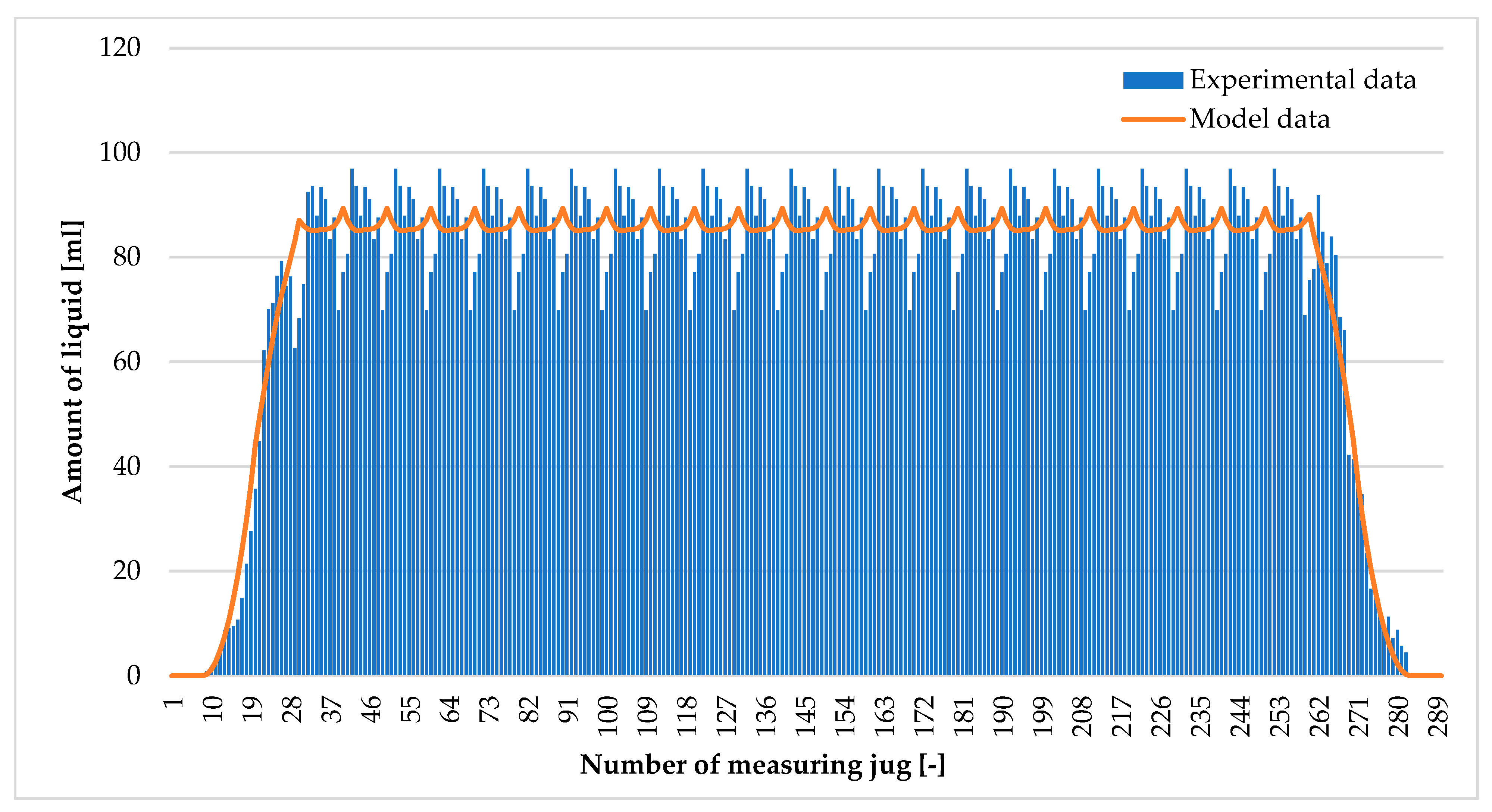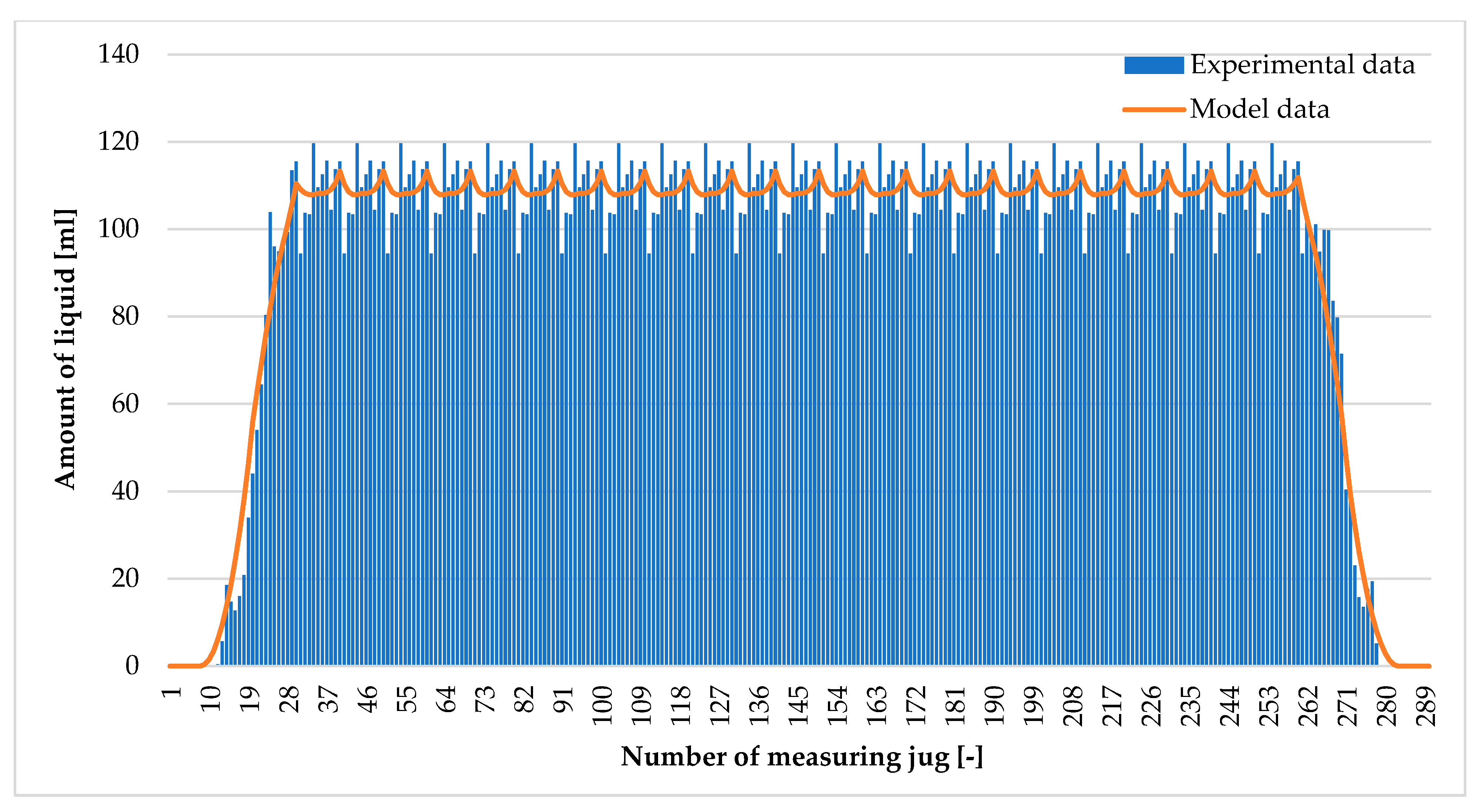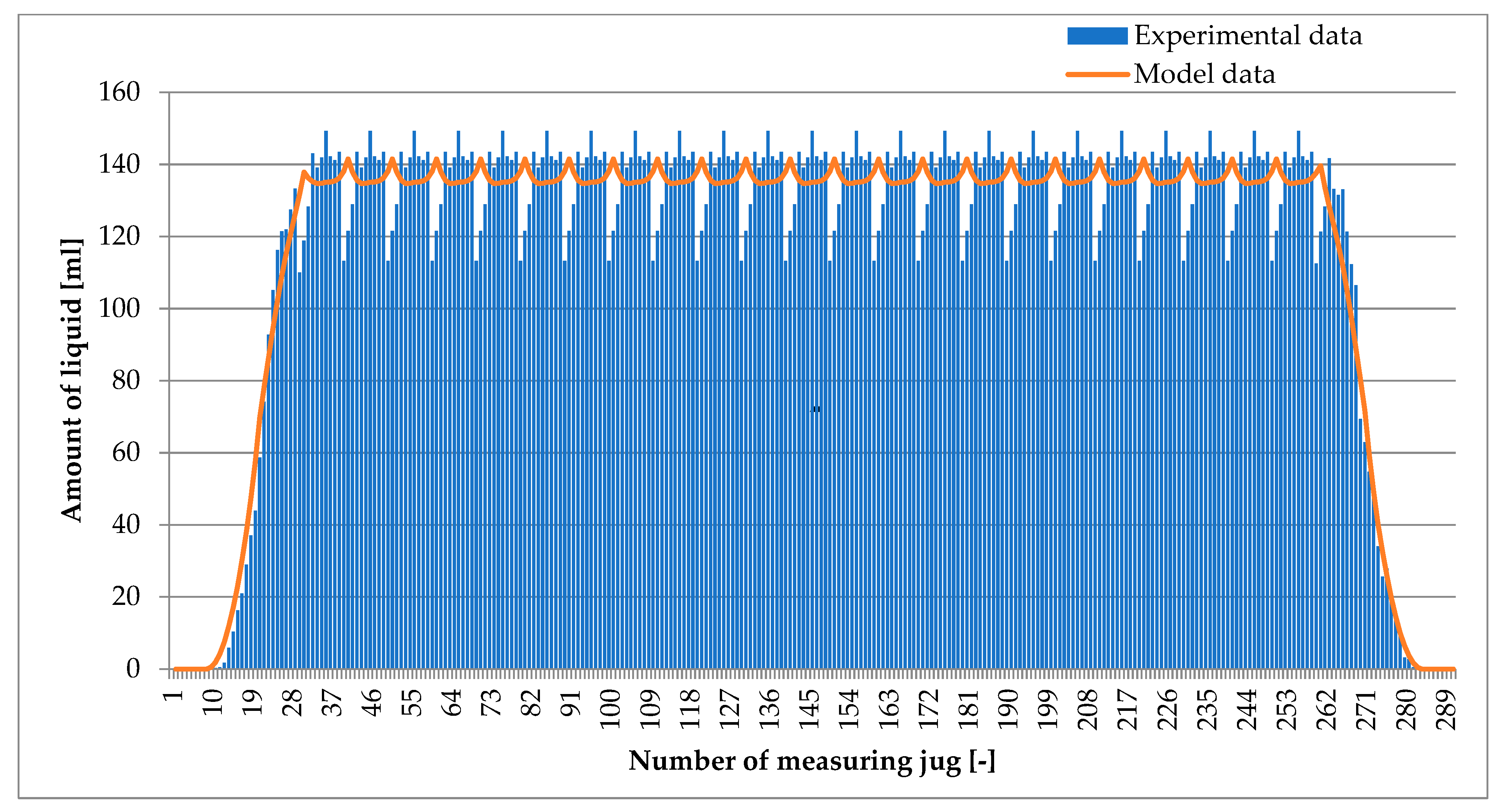Matching the Liquid Atomization Model to Experimental Data Obtained from Selected Nozzles
Abstract
:1. Introduction
2. Materials and Methods
2.1. Experiment Description
- the height of the nozzles above the groove table, 500 mm;
- liquid pressure, 0.3 MPa.
2.2. Development of A New Model of Liquid Amount Distribution
2.3. Statistical Analysis
3. Results
4. Discussion
5. Summary
Author Contributions
Funding
Institutional Review Board Statement
Informed Consent Statement
Data Availability Statement
Conflicts of Interest
References
- Jobbágy, J.; Dančanin, P.; Krištof, K.; Maga, J.; Slaný, V. Evaluation of the Quality of Irrigation Machinery by Monitoring Changes in the Coefficients of Uniformity and Non-Uniformity of Irrigation. Agronomy 2021, 11, 1499. [Google Scholar] [CrossRef]
- Krawczuk, A.; Parafiniuk, S.; Przywara, A.; Huyghebaert, B.; Rabier, F.; Limbourg, Q.; Mostade, O.; Kocira, S. Technical Parameters of Biostimulant Spraying a Determinant of Biometric Traits and Yield of Soybean Seeds. Agric. Eng. 2021, 25, 171–179. [Google Scholar] [CrossRef]
- Chen, C.; Li, S.; Wu, X.; Wang, Y.; Kang, F. Analysis of Droplet Size Uniformity and Selection of Spray Parameters Based on the Biological Optimum Particle Size Theory. Environ. Res. 2022, 204, 112076. [Google Scholar] [CrossRef]
- Forney, S.H.; Luck, J.D.; Kocher, M.F.; Pitla, S.K. Laboratory and Full Boom-Based Investigation of Nozzle Setup Error Effects on Flow, Pressure, and Spray Pattern Distribution. Appl. Eng. Agric. 2017, 33, 641–653. [Google Scholar] [CrossRef] [Green Version]
- Griesang, F.; Spadoni, A.B.D.; Urah Ferreira, P.H.; da Costa Ferreira, M. Effect of Working Pressure and Spacing of Nozzles on the Quality of Spraying Distribution. Crop Prot. 2022, 151, 105818. [Google Scholar] [CrossRef]
- Višacki, V.; Sedlar, A.; Bugarin, R.; Turan, J.; Burg, P. Effect of Pressure on the Uniformity of Nozzles Transverse Distribution and Mathematical Model Development. Acta Univ. Agric. Silvic. Mendel. Brun. 2017, 65, 563–568. [Google Scholar] [CrossRef] [Green Version]
- Lipiński, A.J.; Lipiński, S.; Burg, P.; Sobotka, S.M. Influence of the Instability of the Field Crop Sprayer Boom on the Spraying Uniformity. J. Agric. Food Res. 2022, 10, 100432. [Google Scholar] [CrossRef]
- Cui, L.F.; Xue, X.Y.; Ding, S.M.; Le, F.X. Development of a DSP-Based Electronic Control System for the Active Spray Boom Suspension. Comput. Electron. Agric. 2019, 166, 105024. [Google Scholar] [CrossRef]
- Li, S.; Wang, W. Adaptive Backstepping Robust Control of Nonlinear Spray Boom System. J. Adv. Agric. Technol. 2019, 6, 246–252. [Google Scholar] [CrossRef]
- Çetin, N.; Sağlam, C.; Demir, B. Determination of Spray Angle and Flow Uniformity of Spray Nozzles with Image Processing Operations. J. Anim. Plant Sci. 2019, 29, 1603–1615. [Google Scholar]
- Sayinci, B.; Demir, B.; Açik, N. Comparison of Spray Nozzles in Terms of Spray Coverage and Drop Distribution Uniformity at Low Volume. Turk. J. Agric. For. 2020, 44, 262–270. [Google Scholar] [CrossRef]
- Parafiniuk, S. Conversion of Test Results Obtained for Single Spray Nozzles to Identify the Working Parameters of the Sprayer Boom; Libropolis: Lublin, Poland, 2013. [Google Scholar]
- Lodwik, D.; Pietrzyk, J.; Malesa, W. Analysis of Volume Distribution and Evaluation of the Spraying Spectrum in Terms of Spraying Quality. Appl. Sci. 2020, 10, 2395. [Google Scholar] [CrossRef] [Green Version]
- Shirwal, S.; Veerangouda, M.; Palled, V.; Shilendra, S.; Hosamani, A.; Krishnamurthy, D. Studies on Operational Parameters of Different Spray Nozzles. Int. J. Curr. Microbiol. Appl. Sci. 2020, 9, 1267–1281. [Google Scholar] [CrossRef]
- Nowakowski, T.; Ośko, M. Mathematical Model of Cross-Distribution Non-Uniformity for Twin Flat Nozzle. Ann. Warsaw Univ. Life Sci.—SGGW—Agric. 2017, 69, 5–12. [Google Scholar] [CrossRef]
- Liao, J.; Hewitt, A.J.; Wang, P.; Luo, X.; Zang, Y.; Zhou, Z.; Lan, Y.; O’donnell, C. Development of Droplet Characteristics Prediction Models for Air Induction Nozzles Based on Wind Tunnel Tests. Int. J. Agric. Biol. Eng. 2019, 12, 1–6. [Google Scholar] [CrossRef]
- Wawrzosek, J.; Parafiniuk, S. Optimization of the Opening Shape in Slot Spray Nozzles in a Field Boom Sprayer. Sustainability 2021, 13, 3291. [Google Scholar] [CrossRef]
- Wawrzosek, J.; Parafiniuk, S. The Use of the Permutation Algorithm for Suboptimising the Position of Used Nozzles on the Field Sprayer Boom. Appl. Sci. 2022, 12, 4359. [Google Scholar] [CrossRef]
- Oqielat, M.N.; Turner, I.W.; Belward, J.A.; McCue, S.W. Modelling Water Droplet Movement on a Leaf Surface. Math. Comput. Simul. 2011, 81, 1553–1571. [Google Scholar] [CrossRef] [Green Version]
- Cieniawska, B.; Pentos, K. Average Degree of Coverage and Coverage Unevenness Coefficient as Parameters for Spraying Quality Assessment. Agriculture 2021, 11, 151. [Google Scholar] [CrossRef]
- Musiu, E.M.; Qi, L.; Wu, Y. Evaluation of Droplets Size Distribution and Velocity Pattern Using Computational Fluid Dynamics Modelling. Comput. Electron. Agric. 2019, 164, 104886. [Google Scholar] [CrossRef]
- Duga, A.T.; Delele, M.A.; Ruysen, K.; Dekeyser, D.; Nuyttens, D.; Bylemans, D.; Nicolai, B.M.; Verboven, P. Development and Validation of a 3D CFD Model of Drift and Its Application to Air-Assisted Orchard Sprayers. Biosyst. Eng. 2017, 154, 62–75. [Google Scholar] [CrossRef]
- Wang, J.; Liang, Q.; Zeng, T.; Zhang, X.; Fu, W.; Lan, Y. Drift Potential Characteristics of a Flat Fan Nozzle: A Numerical and Experimental Study. Appl. Sci. 2022, 12, 6092. [Google Scholar] [CrossRef]
- Renaudo, C.A.; Yommi, A.; Slaboch, G.; Bucalá, V.; Bertin, D.E. Prediction of droplet size distributions from a pre-orifice nozzle using the Maximum Entropy Principle. Chem. Eng. Res. Des. 2022, 185, 198–209. [Google Scholar] [CrossRef]
- Tomantschger, K.; Petrović, D.V.; Radojević, R.L.; Tadić, V. Mathematical Method for Droplet Size Distribution of Agricultural Nozzles. Teh. Vjesn. 2021, 28, 1749–1754. [Google Scholar] [CrossRef]
- De Cock, N.; Massinon, M.; Salah, S.O.T.; Lebeau, F. Investigation on Optimal Spray Properties for Ground Based Agricultural Applications Using Deposition and Retention Models. Biosyst. Eng. 2017, 162, 99–111. [Google Scholar] [CrossRef] [Green Version]
- Kaizzi, K.C.; Mohammed, M.B.; Nouri, M. Fertilizer Use Optimization: Principles and Approach. In Fertilizer Use Optimization in Sub-Saharan Africa; CABI: Wallingford, UK, 2017. [Google Scholar] [CrossRef]
- Fytilis, K.; Kontogeorgos, A.; Michailidis, A.; Semos, A. Crop structure optimisation for maximising yield within environmental constraints in a rural area. Int. J. Sustain. Agric. Manag. Inform. 2022, 8, 200–217. [Google Scholar] [CrossRef]
- Echiegu, E.A.; Ede, N.C.; Ezenne, G.I. Optimization of Blaney-Morin-Nigeria (BMN) Model for Estimating Evapotranspiration in Enugu, Nigeria. Afr. J. Agric. Res. 2016, 11, 1842–1848. [Google Scholar] [CrossRef] [Green Version]
- Angaleeswari, M.; Ravikumar, V. Estimating Evapotranspiration Parameters by Inverse Modelling and Non-Linear Optimization. Agric. Water Manag. 2019, 223, 105681. [Google Scholar]
- ISO 16122-2; Agricultural and Forestry Machinery—Inspection of Sprayers in Use—Part 2: Horizontal Boom Sprayers. International Organization for Standardization: Geneva, Switzerland, 2015; p. 18.
- ISO 5682-1; Equipment for Crop Protection—Spraying Equipment—Part 1: Test Methods for Sprayer Nozzles. International Organization for Standardization (ISO): Geneva, Switzerland, 2017.
- Post, S.L.; Hewitt, A.J. Flat-Fan Spray Atomization Model. Trans. ASABE 2018, 61, 1249–1256. [Google Scholar] [CrossRef] [Green Version]
- Ferguson, J.C.; O’Donnell, C.C.; Chauhan, B.S.; Adkins, S.W.; Kruger, G.R.; Wang, R.; Urach Ferreira, P.H.; Hewitt, A.J. Determining the Uniformity and Consistency of Droplet Size across Spray Drift Reducing Nozzles in a Wind Tunnel. Crop Prot. 2015, 76, 1–6. [Google Scholar] [CrossRef]
- Griesang, F.; Decaro, R.A.; Santos, R.T.S.; Vechia, J.F.D.; Santos, C.A.M.; Ferreira, M. Droplet size and uniformity influence on the qualitative and quantitative parameters of agricultural spray. Asp. Appl. Biol. 2018, 137, 217–222. [Google Scholar]
- Butts, T.R.; Luck, J.D.; Fritz, B.K.; Hoffmann, W.C.; Kruger, G.R. Evaluation of Spray Pattern Uniformity Using Three Unique Analyses as Impacted by Nozzle, Pressure, and Pulse-Width Modulation Duty Cycle. Pest Manag. Sci. 2019, 75, 1875–1886. [Google Scholar] [CrossRef] [PubMed] [Green Version]
- Li, L.; Chen, L.; Zhang, R.; Tang, Q.; Yi, T.; Liu, B.; Deng, W. Spray Drift Characteristics of Pulse-Width Modulation Sprays in Wind Tunnel. Int. J. Agric. Biol. Eng. 2022, 15, 7–15. [Google Scholar] [CrossRef]
- Fabula, J.; Sharda, A.; Luck, J.D.; Brokesh, E. Nozzle Pressure Uniformity and Expected Droplet Size of a Pulse Width Modulation (PWM) Spray Technology. Comput. Electron. Agric. 2021, 190, 106388. [Google Scholar] [CrossRef]






| Name of Nozzle | Name of Manufacturer | Type of Nozzle | Flow Rate [L·min−1] | Size of Nozzle | Spray Angle |
|---|---|---|---|---|---|
| XR | TeeJet, Spraying Systems Co. | Standard | 0.8 | 02 | 110° |
| EŻK | MMAT Poland | Air-induction | 0.99 | 025 | 110° |
| RSMM | MMAT Poland | Standard | 1.18 | 03 | 110° |
| AZMM | MMAT Poland | Anti-drift | 1.18 | 03 | 110° |
| IDK | Lechler GMBH | Air-induction | 1.58 | 04 | 120° |
| XR | EŻK | RSMM | AZMM | IDK | |
|---|---|---|---|---|---|
| R | 0.957 | 0.953 | 0.978 | 0.983 | 0.964 |
| R2 | 0.915 | 0.908 | 0.956 | 0.966 | 0.930 |
| a | b | p | q | |
|---|---|---|---|---|
| CV = 1.490% | 0.127 | 0.100 | 2.000 | 1.800 |
| CV = 10.000% | 0.104 | 0.129 | 2.000 | 1.799 |
Disclaimer/Publisher’s Note: The statements, opinions and data contained in all publications are solely those of the individual author(s) and contributor(s) and not of MDPI and/or the editor(s). MDPI and/or the editor(s) disclaim responsibility for any injury to people or property resulting from any ideas, methods, instructions or products referred to in the content. |
© 2023 by the authors. Licensee MDPI, Basel, Switzerland. This article is an open access article distributed under the terms and conditions of the Creative Commons Attribution (CC BY) license (https://creativecommons.org/licenses/by/4.0/).
Share and Cite
Cieniawska, B.; Parafiniuk, S.; Kluza, P.A.; Otachel, Z. Matching the Liquid Atomization Model to Experimental Data Obtained from Selected Nozzles. Appl. Sci. 2023, 13, 4433. https://doi.org/10.3390/app13074433
Cieniawska B, Parafiniuk S, Kluza PA, Otachel Z. Matching the Liquid Atomization Model to Experimental Data Obtained from Selected Nozzles. Applied Sciences. 2023; 13(7):4433. https://doi.org/10.3390/app13074433
Chicago/Turabian StyleCieniawska, Beata, Stanisław Parafiniuk, Paweł A. Kluza, and Zdzisław Otachel. 2023. "Matching the Liquid Atomization Model to Experimental Data Obtained from Selected Nozzles" Applied Sciences 13, no. 7: 4433. https://doi.org/10.3390/app13074433






